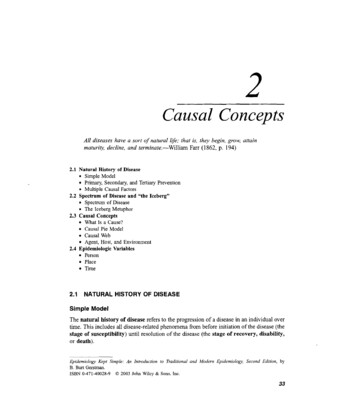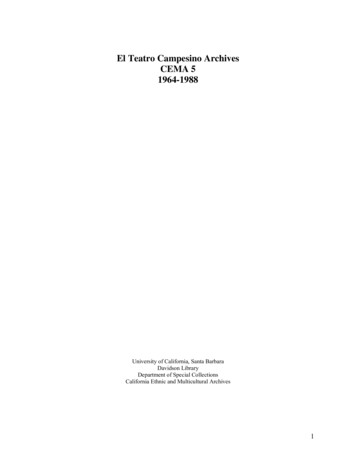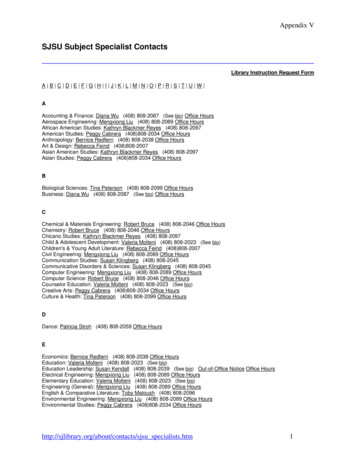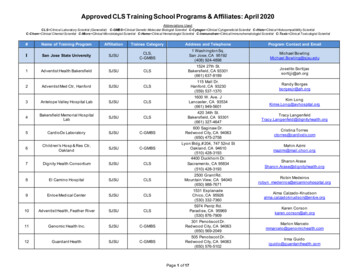
Transcription
2Causal ConceptsAll diseases have a sort of natural life; that is, they begin, grOM-; attainmaturity, decline, and terminate.-William FaIT (1862, p. 194)2.1 Natural History of Disease Simple Model Primary, Secondary, and Tertiary Prevention Multiple Causal Factors2.2 Spectrum of Disease and "the Iceberg" Spectrum of Disease The Iceberg Metaphor2.3 Causal Concepts What Is a Cause?Causal Pie ModelCausal WebAgent, Host, and Environment2.4 Epidemiologic Variables Person Place Time2.1NATURAL HISTORY OF DISEASESimple ModelThe natural history of disease refers to the progression of a disease in an individual overtime. This includes all disease-related phenomena from before initiation of the disease (thestage of susceptibility) until resolution of the disease (the stage of recovery, disability,or death).Epidemiology Kept Simple: An Introduction to Traditional and Modern Epidemiology, Second Edition, byB. Burt Gerstman.ISBN 0-471-40028-9 2003 John Wiley & Sons, Inc.33
34CAUSAL CONCEPTSFigure 2.1 is a schematic of the natural history of a disease when consideringthe ultimate (last) causal exposure in a simple causal model. In the period followingexposure to the agent, the prospective case enters a stage of subclinical disease (alsocalled the preclinical phase). This corresponds to the time during which the etiologicagent is present within the body but has not yet produced discernible signs or symptoms.This phenomenon was recognized by Jacob Henle more than a century-and-a-half agowhen he wrote "the symptoms of disease do not appear directly after the entry of thecontagious agent but rather after a certain period, which varies with different contagions"(Henle, 1840, p. 14).Both infectious and noninfectious agents are characterized by subclinical stages ofdisease. With infectious diseases, this corresponds to the incubation period. Withnoninfectious diseases, this may be called the latent period or (loosely) the empiricalinduction period. In considering a cancer, for example, the latent period corresponds tothe time between the ultimate neoplastic transformation that leads to nondifferentiated anduncontrolled cell proliferation and the progression of these changes to a state that producesrecognized physiologic disturbances.Incubation periods vary considerably for agent-disease pairs. Some diseases arecharacterized by short incubation periods (e.g., cholera has a brief 24- to 48-hourincubation period), others by intermediate incubation periods (e.g., chickenpox has atypical incubation period of2 to 3 weeks), and still others by extended incubation [e.g., themedian incubation period of acquired immunodeficiency syndrome (AIDS) is approxi mately 10 years]. Table 2.1 lists incubation periods for selected infectious disease agents.Notice that even for a given disease incubation periods can vary considerably. For example,the incubation period for human immunodeficiency virus (HIV) and AIDS ranges from 3Onset ofSymptomsExposureIncubation PeriodPathologicChangesTime of DiagnosisStage ofStage ofStage ofStage of Recovery,SusceptibilitySubclinical DiseaseClinical DiseaseDisability, or DeathPrimaryPrevention:Intended toreduce newoccurrencesSecondaryPrevention:Intended toreduceduration andseverityTertiaryPrevention:Intended toreducecomplicationsand disabilitiesLevel ofPreventionFigure 2.1. Stages in the natural history of disease and prevention, ultimate agent.
2.135NATURAl HISTORY OF DISEASETABLE 2.1. Incubation Periods for Selected infectious DiseasesDiseaseAcquired immune deficiency syndromeAmebiasisChickenpoxCommon coldHepatitis BInfluenzaLegionellosisMalaria (Plasmodium vivax and P. ovale)Malaria (P. malariae)Malaria (P. Falciparum)MeaslesMumpsPoliomyelitis, acute taphylococcal food poisoningTetanusTypical Incubation Period"Infection to appearance of antibodies: 1-3 months;median time to diagnosis: approx. 10 years;treatment lengthens the incubation period2-4 weeks13-17 days2 days60-90 days1-5 days5-6 days14 days30 days12 days7-18 days12-25 days7-14 days2-6 days2-8 weeks (depends on severity of wound)12-36 hours2-6 weeks2-4 days3-21 daysSource: Benensen (1990).aThe incubation periods of some diseases vary considerably. See the latest edition of Controlof CommunicableDiaseases in Man (Benensen, 1990) for details.to more than 20 years. The empirical induction period for leukemia caused by exposure tothe faliout from the atomic bomb blast in Hiroshima ranged from 2 to more than 12 years(Cobb et aI., 1959). The empirical induction period for bladder tumors in industrialdyestuff workers ranges from 5 to more than 40 years (Fig. 2.2). Variability in incubation isdue to differences in host resistance, pathogenicity of the agent, exposure-dose, and theavailability of cofactors responsible for disease.The stage of clinical disease begins with a patient's first symptoms and ends withresolution of the disease through recovery, disability, or death. Depending on host factors,speed of the disease process, and efficacy of the health-care system, the lag between theonset of symptoms and diagnosis may be considerable. Therefore, it is the onset ofsymptoms and not the time of diagnosis that marks the beginning of the clinical stage ofdisease.Understanding the natural history of a disease is essential when studying its epide miology. For example, AIDS can only be understood after identifying the multifariousstages of Hl'V infection (Fig. 2.3). Exposure to HIV is followed by an acute response thatmay be accompanied by unrecognized flulike symptoms. Although prospective cases donot exhibit detectable antibodies until approximately 6 weeks foliowing the initialinfection, they can still be infectious during this acute phase. A lengthy incubation periodensues during which CD4 lymphocyte counts decline and the patient is free fromsymptoms. The risk of developing AIDS is low during the initial years of infection butincreases over time as the immune response is progressively destroyed. AIDS thenexpresses itself in many different ways (e.g., opportunistic infections, various cancers,dementia, wasting syndrome).
36CAUSAL CONCEPTS100-80r-- (J)tD(J)CIl60 -r-- o'0Q;.0E z40-I--- 20o o10203040,.--,50Empirical Induction Time In YearsFigure 2.2. Distribution of empirical induction period of urinary bladder tumors in industrial dyestuffworkers. (Source: Case et al., 1954, p. 85; reproduced with permission of BMJ Publishing Group.)Primary, Secondary, and Tertiary PreventionDisease prevention efforts can be classified according to the stage of disease at which theyare applied (Fig. 2.1). Primary prevention is directed toward the stage of susceptibility,before the pathogen establishes itself in the body. The goal of primary prevention is toprevent the disease from occurring in order to reduce its incidence in the community.Examples of primary prevention include needle-exchange programs to prevent the spreadof HIV, various vaccination programs, and smoking prevention programs.Secondary prevention is directed toward the subclinical stage of disease, in peoplewho carry the agent but are not yet symptomatic. That goai of secondary prevention is toeither delay the emergence of disease or reduce its severity once it emerges. Treatingasymptomatic HIV-infected patients with antiretroviral agents to delay the onset of AIDS isa form of secondary prevention. Screening for cervical cancer via Pap smears is also aform of secondary prevention.Tertiary prevention is directed toward the clinical stage of disease. The aim of tertiaryprevention is to prevent or minimize the progression ofthe disease or its sequelae. Screeningpeople with diabetes for diabetic retinopathy to promptly treat the progression ofblindness isa form oftertiary prevention. Tertiary prevention is especially import for preventing disabilityand containing the costs of health care associated with chronic degenerative conditions.Multiple Causal FactorsA central tenet of modem epidemiology is that every cause is interdependent on othercausal factors. That is, diseases are caused by the cumulative effect of a number of factors.
2.137NArURAL HISTORY OF DISEASETuberculosisBacterial InfectionI stationsACUTERESPONSEEXPOSUREINFECTIONRISK FACTORSPRESENTDEMENTIA- ------,OPPORTUNISTICINFECTIONSCD4 CELL NUMBER 200Prognostic Indicators"AIDS"Prognostic IndicatorsHIVAb3-? YEARSTIME1-3YEARSFigure 2.3. Natural history and progression of HIV infection and AIDS. (Source: Caftan, D. J. (1995).The natural history of HIV infection: implications for clinical trials. In D. M. Finkelstein & D. A. Schoenfeld(Eds.). AIDS Clinical Trials, p. 8; Copyright 1995 by Wiley-Liss, Inc. Reprinted by permission of Wiley Liss, inc., a subsidiary of John Wiley & Sons, Inc.)Even infectious disease agents do not act alone. Two people exposed identically to thesame infectious agent experience different symptoms-sometimes no symptoms at all depending on various agent, host, and environmental contributors (see Section 2.3). Whenconsidering multiple causal factors, a sophisticated view of "incubation" is needed. This isaided by considering separate induction and latent periods. The induction period of acausal factor is the time between its causal action and initiation of the disease (Fig. 2.4).The latent period of a disease is the time between disease initiation and disease detection.The combined induction and latent periods is the empirical induction period (Rothman,1981).Consider as an example the relation between dietary fats and myocardial infarction.Excessive dietary fat consumption exerts one of its causal actions through atherosclerosis.However, the effects of this causal action may not be seen until a blood clot gets lodged inthe affected coronary vessel. Many years may pass between the causal action of coronaryEmpirical Induction PeriodICausalActionInduction PeriodI Latent Period IDiseaseInitiationDiseaseDetection(Biological Effect)TimeFigure 2.4. Induction period, latent period, and empirical induction period.
38CAUSAL CONCEPTSEmpiricallnducllon for G- - - - Empirical Induction for E- - - - I.Induction E1 ---GeneticSusceptiblityInduction GCu mulative DoseEnvironmentalExposureCausal )Figure 2.5. Induction periods for genetic and environmental (excessive dietary fats) for myocardialinfarct.narrowing and the infarct that initiates myocardial ischemia. In the meantime, other causalfactors may contribute to the disease process (e.g., hypertension, obesity, sedentarylifestyle, genetic factors), each exerting its causal action, directly or indirectly.Conceptualizing the induction period for a chronic exposure is particularly challengingwhen a cumulative dose is involved in its biological effect. Figure 2.5 is a schematic of thenatural history of a thromboembolic-induced myocardial infarct. Let G represent geneticsusceptibility to coronary atherosclerosis, and let E represent exposure to excessive dietaryfats. To simplify matters, only these two causal factors and the ultimate infarct that initiatesthe disease are considered. Assume G exerts its causal action at conception and E exerts itscausal action after an arbitrary exposure dose is achieved. Notice that G and E havedifferent induction periods. For G, the induction is from conception to initiation ofmyocardial ischemia. For E, the induction is from the point of atherosclerosis to infarction.Because the effects of the infarct are acute, the latent period between infarction andsymptoms is typically short. (The diagram is not drawn to scale to allow for labeling.)2.2 SPECTRUM OF DISEASE AND "THE ICEBERG"Disease known to the general practitioner represents only the tip of the iceberg-John Last(1963, p. 30)Spectrum of DiseaseA particular disease can display a broad range of manifestations and severities, rangingfrom silent in some people to progressive and fulminating in others. When consideringinfectious diseases, this range of manifestations is referred to as the gradient of infection.When considering noninfectious diseases, the range of manifestations is referred to as thespectrum of disease. For example, HIV infection ranges from inapparent, to mild disease(e.g., AIDS-related complex), to severe disease (e.g., wasting syndrome). Coronary arterydisease exists in the following forms: asymptomatic atherosclerosis, compromised cardiaccirculation resulting in transient ischemia and angina, myocardial infarction, and death.
2.239SPECTRUM OF DISEASE AND "THE ICEBERG"The Iceberg MetaphorThe spectrum of some illnesses has been liked to an iceberg, in that like an iceberg, thebulk of the problem may be hidden from view (Last, 1963; Fig. 2.6). This phenomenonapplies to chronic diseases, injuries, and infectious diseases and may be either quantitativeor qualitative in exhibited differences. Uncovering disease that might otherwise bebelow "sea level" by screening and early detection may allow for better disease control.Consider: For every successful suicide attempt there are many more unsuccessful attempts and astill larger number of people with depressive illness that might be severe enough tohave them wish to end their lives. With appropriate treatment, depressives withsuicidal tendencies would be less likely to have suicidal ideation and be less likely toattempt suicide. Reported cases of AIDS represents only the tip of HIV infections. With properantiretroviral therapy, clinical illness may be delayed and transmission averted.Apparent1------. (Clinical)DiseaseFigure 2.6. Iceberg metaphor.
40CAUSAL CONCEPTSAPPARENTFROMHOSPITALSURVEILLANCEANDDEATH RECORDSINAPPARENTFROMHOSPITALSURVEILLANCEFigure 2.7. Approximate number of dog bite injuries in the United States annually. (Based on Weisset al., 1998). Serious dog bite injuries often go undetected. For each fatal dog bite there are about670 dog bite hospitalizations, 16,000 emergency department visits, 21,000 medicalvisits to other clinics, and 187,000 nontreated bites (Weiss et aI., 1998; Fig. 2.7). Witheffective recognition, animal control programs can be put into place to prevent dogbite injuries.Screening for disease below the surface of normal detectability can be part of an effectivedisease control program.2.3CAUSAL CONCEPTSOne reason that the notion of "cause" is so important is that it carries suggestions ofrelations at a deeper level of understanding than the direct observation under study.--Cox(1986, p. 963)
2.341CAUSAL CONCEPTSWhat Is a Cause?Definition The Oxford English Dictionary (second edition) defines a cause as "thatwhich produces an effect," while Webster 50 New Collegiate (9th edition) defines a cause as"something that brings about an effect or a result." The 18th-century British philosopherDavid Hume (1772, Section VII) defined a cause as. an object, followed by another, and where all the objects similar to the first are followed byobjects similar to the second. Or in other words where, if the first object had not been, thesecond never had existed.Thus, a causal factor is an event, an act, a condition, or a state of nature that "initiates orpermits, alone or in conjunction with other causes, a sequence of events, resulting in aneffect" (Rothman, 1976, p. 588). Some epidemiologists use the term determinantinterchangeably with "cause," defining a determinant as "any factor . that brings aboutchange for better or worse in a health condition" (Susser, 1973, p. 3). In addition, modemepidemiologic definitions of disease causation incorporate an essential element of time: Acause of disease is "an event, condition or characteristic that preceded a disease withoutwhich the disease event either would not have occurred at all or would not have occurreduntil some later time" (Rothman & Greenland, 1998, p. 8). If not for the causal factor, thedisease would not have occurred or would have occurred later in the life of the individual.On a population basis, we expect that a change in the level of a causal factor will beaccompanied by an increase (or decrease, since in some instances causal factors arepreventive) in the incidence of disease, caeteris parabus (all other things being equal). Wealso expect that if the causal factor can be eliminated or diminished, the frequency ofdisease or its severity will decline.Necessity and Sufficiency In epidemiology, the term exposure has developed tomean any condition considered as a possible cause of disease. An exposure is said to benecessary when it always precedes the disease. An exposure (or more, realistically, a set ofexposures) is considered sufficient when disease becomes inevitable. Four possibilitiesexist:Exposure E isNecessarySufficient123 41. Causal exposure E is both necessary and sufficient if E and disease D are alwayspresent together and E acting alone inevitably leads to D (E --- D). Rarely, if ever,are single exposures necessary and sufficient to cause disease. A possible exceptionto this is in the case of a homozygous genetic abnormality, such as seen in Tay Sachs disease. But even here, a case can be made that other factors were requiredbefore the disease became manifest. Two heterozygous recessive Tay-Sachs parentsneeded to mate, the recessive alleles needed to be contributed by both parent, genetic
42CAUSAL CONCEPTSand prenatal screening needed to be avoided, and so on. One can nearly always findother contributing components to a causal mechanism.2. Causal exposure E is necessary but not sufficient if E is always present whendisease D occurs but D does not always occur in the presence of E. A cause isnecessary when it is part of the definition of the disease, as with infectiousphenomena. For example, Mycobacterium is necessary for tuberculosis. However,the tubercular bacterium is not always sufficient to cause the disease-it is possiblefor a person to carry Mycobacterium in his or her body yet remain asymptomatic.This implies that complementary factors (F) are required for disease to becomemanifest (E F -- D). In the case of tuberculosis, complementary factors includefamilial exposure, immunosuppression, genetic susceptibility, poor nutrition,overcrowding, failure to diagnose and treat during the asymptomatic stages ofdisease, multiple drug resistance, and so on.3. Causal exposure E is not necessary but is sufficient for disease D if D can occur inthe absence of E, but D always occurs in its presence (E -- D; F -- D). Forexample, Down syndrome always leads to mental retardation, but other perinatalfactors may also cause this outcome. As was the case in scenario 1, a case can bemade that sufficiency of a single factor is rare in epidemiology (e.g., contributingcauses of Down syndrome include older maternal age, lack of screening,consanguineous marriages, and teratogenic factors).4. Explanatory factor E is neither necessary nor sufficient in causing disease D if Emayor may not precede D. This implies that additional factors (F) must accompanyE in causing disease (E F -- D; F G -- D; etc.). For example, cigarettesmoking is neither necessary nor sufficient to cause lung cancer--even under themost extreme conditions, lung cancer will affect only a fraction of smokers, and lungcancer can occur in the absence of smoking. Most causal factors in modemepidemiology fall into this category.Indispensable Part of a Causal Mechanism So how then do we think aboutnonnecessary, nonsufficient causal factors? Briefly, each cause is viewed as a causalcomponent of a multifactored causal mechanism. For example, high serumcholesterol, while neither necessary nor sufficient to cause a myocardial infarct, isan indispensable part (component) of myocardial infarction in many individuals.This multicomponent view of causality contrasts with the now antiquated"unitector" (single agent) conception of disease etiology proposed by JakobHenle in 1849 and later modified by his student Robert Koch in 1882. The followingcriteria form the basis of the Henle-Koch postulates:1. The agent must be present in each and every case of the disease (i.e., the agent isnecessary).2. The agent can occur in no other disease as a fortuitous or nonpathogenic parasite(i.e., the agent is specific).3. The agent must be isolated from the body of an infected host in pure culture andmust be capable of repeatedly causing the disease anew in a susceptible host (i.e.,the agent is sufficient).
2.343CAUSAL CONCEPTSLimitations of Koch's postulates in explaining both infectious and noninfectiousdiseases are now widely recognized. Even Koch did not regard his postulates as strictcriteria, realizing almost immediately that many bacterial agents could not be expected tofulfill criterion 2 and criterion 3-he was aware of the various carrier states in which theagent was nonpathogenic and recognized that exposure to the cholera bacillus was notsufficient by itself to produce cholera in all individuals. It is ironic that Jakob Henle'sgrandson, Werner Henle, helped establish the causal relationship between Epstein- Barrvirus and mononucleosis without fulfilling a single one of his grandfather's postulates(Evans, 1978). Nevertheless, the epidemiologist must be aware that many people fall intothe habit of using the one-to-one correspondence between cause and effect that is typical ofthe Koch- Henle postulates.Causal Pie ModelRothman's (1976) causal pie (sufficient/component cause) model helps clarify hownecessary and nonnecessary component causes contribute to disease occurrence on apopulation level. Figure 2.8 is a causal pie model representing a particular disease. Twocausal mechanism are possible, each involving multiple causal components. Factor A inthis example is a necessary component cause, since it always precedes the disease. FactorsB, C, and D are nonnecessary component causes.A causal complement of a factor is the factor or set of factors that completes a givencausal mechanism. In Figure 2.8, the causal complements of A are (B C) and D; thecausal complement of factor B is (A C); the causal complement of factor C is (A C);the causal complement of factor D is A. Factors that work together in a given causalmechanism are said to be interdependent or interact causally. For example, when aperson develops an infectious disease, the infectious agent interacts with lack of immunityto cause disease. Falling or some form of trauma interacts with osteoporosis to cause hipfractures in the elderly. Smoking interacts with genetic susceptibility and otherenvironmental carcinogens to cause lung cancer. Dietary factors interact with lack ofexercise, genetic susceptibility, and arterial thromboembolism to cause a heart attack.Thus, causal interdependencies (interactions) have direct health relevance.Sufficient CausalMechanism 1Sufficient CausalMechanism 2A, S, C, and Dare component causes.A is a necessary component cause.Figure 2.8. Two mechanisms of disease represented with causal pies.
44CAUSAL CONCEPTSThe causal pie model highlights the fact that individual risk is an all-or-nonephenomenon. In a given individual, either a causal mechanism is completed or it is not. Infact, the notion of risk is useful only when an individual is regarded as a member of arecognizable subgroup of the population. For example, we may speak of the risk of lungcancer in 50- to 55-year-old men who have smoked one pack of cigarettes per day for 30years. We can then say the risk in that particular population subunit is the expectedproportion in the group that develops lung cancer.Causal pies can also be used to illuminate how the effects of a causal exposure dependon the prevalence of its causal complements in the population. The effect ofphenylketanines, for instance, depends on the prevalence of the inborn error of catabolismmarked by the absence of phenylalanine hydroxylase known as phenylketonuria. Theeffect of the sickle-cell trait depends on the prevalence of the falciparum malaria protozoanand female Anopheles mosquitos in the environment. The effects of falls in the elderlydepends on the prevalence of osteoporosis in the group.Hogben's (1933) discussion of yellow shank disease in chickens provides a memorableexample of how the population effects of an agent cannot be separated from the prevalenceof its causal complements in the population (MacMahon & Pugh, 1970). The trait of yellowshank in poultry is a condition expressed only in certain genetic strains of fowl when fedyellow com. A farmer with a susceptible flock who switches from white com to yellow comwill perceive the disease as entirely environmental. A farmer who feeds only yellow com toa flock with multiple strains of chickens, some of which are susceptible to the yellow shankcondition, will perceive the condition as entirely genetic. In fact, the effects of yellow comcannot be separated from the genetic makeup of the flock, and the effect of the geneticmakeup of the flock cannot be separated from the presence of yellow com in theenvironment. To ask whether yellow shank disease is environmental or genetic is likeasking whether the sound of a faraway drum is caused by the drum or the drummer-onedoes not act without the other-there is an interdependence (causal interaction).Causal WebTo ascertain the cause ofcholera. we must consider it not only in individual cases, but also inits more general character as an epidemic.-John Snow (1849, p. 746)The causal web is a metaphor that emphasizes the interconnectedness of casualcomponents in a population. We speak of direct causes and indirect causes comprisingcausal webs. Direct causes are proximal to pathogenic events. Indirect causes are distal("upstream") from pathological events. For example, occlusion of a coronary artery via ablood clot is a direct cause of a myocardial infarction, whereas social and environmentalfactors that lead to hyperlipidemia, obesity, a sedentary lifestyle, arteriosclerosis, andcoronary stenosis are indirect causes. In considering a given disease, indirect and directcauses form a hierarchical causal web, often with reciprocal relations among factors. Acasual web model is shown in Figure 2.9.Levels of cause in a causal web may be classified as: Macrolevel (including social, economic, and cultural determinants) Individual-level (including personal, behavioral, and physiological determinants) Microlevel (including organ system, tissue, cellular, and molecular determinants)
Industrialsociety----.--- Increasedcatecholamines C1lThrombotictendencyFigure 2.9. Causal-web model for myocardial infarction. (Source: Friedman, G. D. (1974). Primer of Epidemiology. New York: McGraw-Hili; reproduced with thepermission of the McGraw-Hili Companies.)
46CAUSAL CONCEPTSFigure 2.10 considers these levels of cause for early childhood mortality in non industrialized countries. In this example, the macrolevel encompasses broad social,economic, and cultural conditions that lead to a paucity of food, shelter, and sanitation.Individual-level causes include child-care practices that expose children to pathogens,malnutrition, and dehydration. Microlevel causes include the immediate pathophysiologicinteraction between malnutrition and the pathogenic respiratory and gastrointestinal agentsthat ultimately lead to death (Millard, 1994).The relative contribution of these various levels of study in epidemiology and publichealth have been the subject of considerable and sometimes contentious debate. withadvocates for each level of study claiming particular and general benefits to their way ofaddressing problems. In practice, however, advocating one or another level may hinderachieving the most practical strategy for preventing a given disease. Maintainingfragmented methods of research into the various levels of disease occurrence can onlyobstruct understanding and ultimately delay effective prevention measures (Savitz, 1997).Agent, Host, and EnvironmentCausal components can be classified as agent, host, or environmental factors (Fig. 2.11).Agents are biological, physical, and chemical factors whose presence, absence, or relativeamount (too much or too little) are necessary for disease to occur (Table 2.2). Host factorsinclude personal characteristics and behaviors, genetic predispositions, and immunologicand other susceptibility-related factors that influence the likelihood or severity of disease.Environmental factors are external conditions other than the agent that contribute to thedisease process. Environmental factors can be physical, biologic, or social in nature.Multiple agent, host, and environmental factors are viewed in interdependent ecologicalterms. Over time, it is possible for causal and preventive factors to form an epidemiologicMacroSocial andEnvironmentaljjIndividualPersonal andBehavioraljMicroFood, Shelter,SanitationjChildcare Practicesthat IncreaseLikelihood ofMalutrition andExposure!Biophysical andBiomedicalMalnutrition &InfectionjjDiseaseChildhood MortalityFigure 2.10. Mecro-, individual-, and microlevels of cause for early childhood mortality innonindustrialized countries.
2.347CAUSAL CONCEPTSHostEnvironmentFigure 2.11. Agent, host, and environment triad.homeostasis. Epidemics may arise when the relative influence of factors are thrown out ofbalance. For example, an epidemic may arise from any of the following: Introduction of a new agent into the populationIncreases in the ability of an agent to survive in the environmentIncreases in an agent's ability to infect the host (infectivity)Increases in the ability of the agent to cause disease once inside the host(pathogenicity)Increases in the severity of the disease caused by the agent once it has establisheditself in the host (virulence)Increases in the proportion of susceptibles in the populationEnvironmental changes that favor growthEnvironmental changes that favor transmission of the agentEnvironmental changes that compromise host resistanceCausal forces can strengthen, weak
the ultimate (last) causal exposure in a simple causal model. In the period following . the time between the ultimate neoplastic transformation that leads to nondifferentiated and . before the pathogen establishes itself in the










